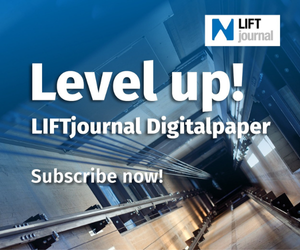By Thomas Busch
They combine all the processes on a digital platform, create transparency and raise productivity and economic efficiency to new levels. This can become a decisive competitive advantage for lift builders. But what should you pay attention to when selecting a system?
Fully digital processes and automations are the key to efficient company processes. This is precisely where “Enterprise Resource Planning” systems (ERP) come in: these integrated software solutions map complete business processes on a uniform platform. For lift builders, this means seamless connection of information across all departments, from design, production, assembly, maintenance, spare part management, purchasing and distribution to administration.
Save time with automations
The advantages of ERP systems include greater efficiency, improved data quality and standardised processes, which can be easily automated. This leads to a reduction in error sources and better capacity utilisation of personnel and machinery. Disadvantages may consist in the complexity of the systems, which means employees first have to be trained. In addition, the investment costs for procurement, modification and maintenance are not inconsiderable while the conversion of existing processes is often time-consuming.
But the expense can be worth it. “We had to look for a new ERP system this year since Orderbase is going to halt support for our purchased version,” explained Thomas Wieland, managing director of the TAF Aufzugsdienst Mannheim GmbH and member of the Board of Directors of the GAT Gemeinschaft Aufzugs-Technik. “Finding a paperless system that was specialised in the lift sector and offered fast support in the event of problems was important to us. We then decided on the cloud solution from Mainteny in May 2025.”
Since then, customers of the company have benefited from more service and the employees from less time expended. “Our offers are produced within minutes thanks to well-designed templates, fitters get their jobs per app directly on their smartphones and thanks to the automatic despatch of work reports, customers are always up-to-date,” revealed Thomas Wieland.
Sector-specific solutions
Precisely this is the biggest advantage of ERP systems: complex projects are easy to manage and monitor digitally – from individual planning of lifts, procurement of components, punctual assembly and invoicing to later service deployments.
However, before selecting an ERP system, lift builders should carefully check the functionality. “This is because most ERPs share a fundamental fault,” explained Lindert, member of the executive management and CPO of Dauer Aufzüge GmbH in Panketal. “The process hierarchy is always focused on the customer. But this is the wrong approach for our sector since the only unchangeable element in the added value chain is the lift. All other roles – whether owner, testing organisation or facility manager – can change at any time. That’s why the essential thing for us was to find a system that was specialised in the lift sector and subordinated everything else to the particular lift.”
On these grounds, the company decided on “Paternoster” from basic ERP GmbH in April 2019. “What we wanted to find was a platform-independent, economical and web-based solution that could be used via a browser and be installed locally in our company,” Lars Lindert elaborated. “In addition, it had to be an open source system to enable us to continue to use it with our own programmers if the provider at some point stopped supporting it.”

Long-term competitive advantages
Before deciding on an ERP solution, lift builders would be well-advised to carefully analyse their own business processes. Apart from the points already mentioned, important criteria when selecting a system are the availability of relevant interfaces and the option to integrate mobile applications for assembly and service teams. Aspects such as scalability, data security and the observance of statutory requirements are crucial.
Conclusion: Only an ERP system that is perfectly tailored to the particular company processes and complex procedures in lift building can secure the company long-term competitive advantages.
Checklist: the ideal ERP system for your company
1. Needs analysis
- Recording of all company processes: order processing, maintenance, material procurement, inventory management, project management
- Determination of priorities: which processes are to be mapped in the ERP system?
2. Functional scope
- Modules for purchasing, storage, production, service and maintenance of lifts?
- Finance and accounting, including cost centres and project accounting?
- Integration of CRM and document management systems?
- Interfaces to existing systems (CAD, time recording, mobile service apps)?
3. User-friendliness
- What operating systems are supported? Is use via browser possible?
- Intuitive user interface for fitters, technicians and administration?
- Mobile use for sales force and service?
- Adjustable dashboards for different departments?
4. Flexibility
- Expandable in the event of growing project volumes or new business fields?
- Adjustable to the requirements of lift builders?
5. Installation
- Local installation: High degree of control, own server, internal maintenance, greater initial investment
- Cloud/SaaS: Lower IT costs, access from everywhere, automatic updates, greater dependence on provider
- Weighing up costs, data security and own IT
expertise
6. Interfaces
- Connection to bookkeeping software, CAD
systems, time recording and customer portals?
- Standardised interfaces to minimise error
sources?
- Option to expand with third-party provider
software?
7. Data security
- GDPR-compliant storage and processing of customer data?
- Role- and rights administration for employees?
- Encryption of sensitive data and regular backups?
8. Economic efficiency
- Procurement costs vs regular licence fees?
- ROI analysis (efficiency increase, time-saving, error reduction)?
- Training and implementation costs?
9. Support
- Availability of technical support, training courses, online resources?
- Option of internal training courses?
- Reaction time and availability in the event of malfunctions?
10. Test phase
- Use of demo versions before decision?
- Obtain feedback from all departments
More informations: es2000.de
mainteny.de
orderbase.de
basic-erp.com
shm-software.de


























Write a comment